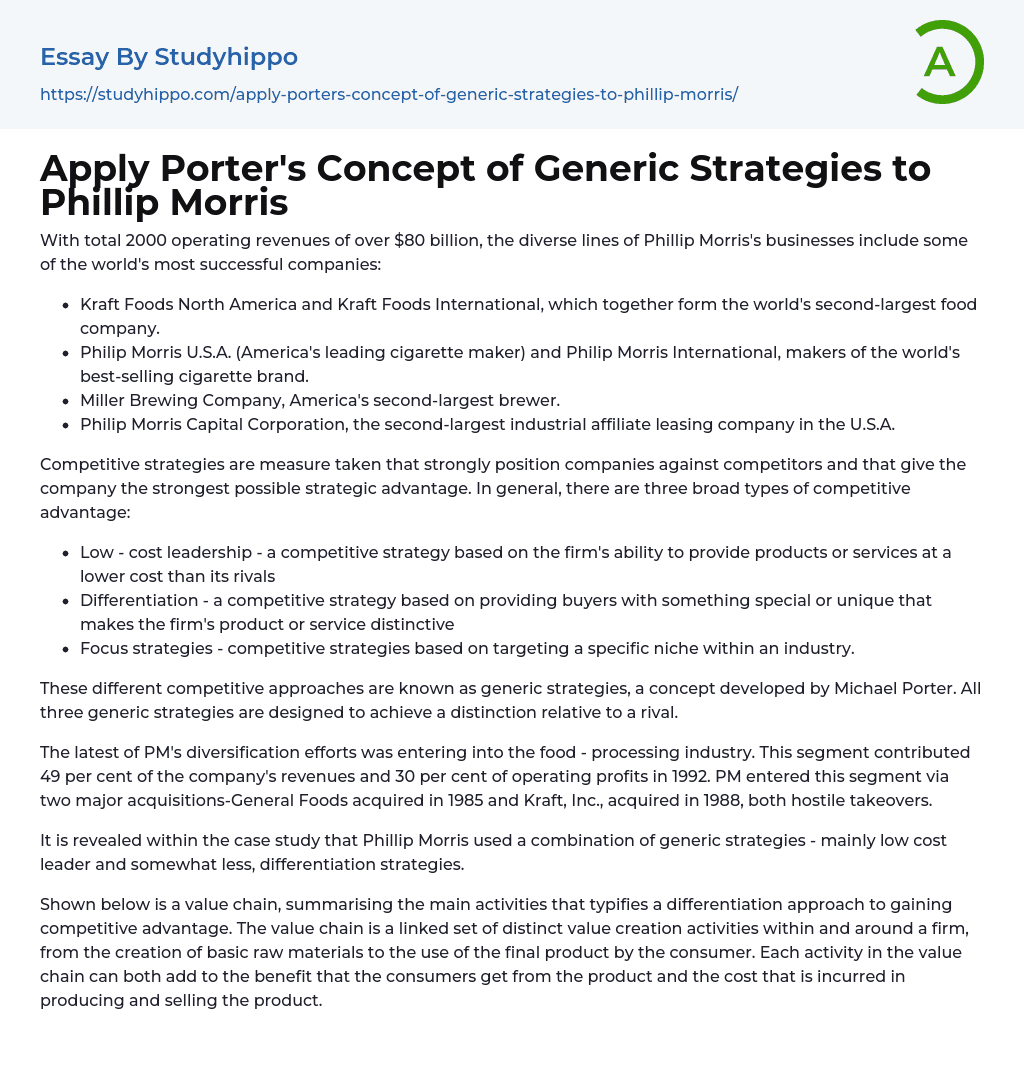

Apply Porter’s Concept of Generic Strategies to Phillip Morris Essay Example
With total 2000 operating revenues of over $80 billion, the diverse lines of Phillip Morris's businesses include some of the world's most successful companies:
- Kraft Foods North America and Kraft Foods International, which together form the world's second-largest food company.
- Philip Morris U.S.A. (America's leading cigarette maker) and Philip Morris International, makers of the world's best-selling cigarette brand.
- Miller Brewing Company, America's second-largest brewer.
- Philip Morris Capital Corporation, the second-largest industrial affiliate leasing company in the U.S.A.
Competitive strategies are measure taken that strongly position companies against competitors and that give the company the strongest possible strategic advantage. In general, there are three broad types of competitive advantage:
- Low - cost leadership - a competitive strategy based on the firm's ability to provide products or services at a lower cost than its riva
...ls
- Differentiation - a competitive strategy based on providing buyers with something special or unique that makes the firm's product or service distinctive
- Focus strategies - competitive strategies based on targeting a specific niche within an industry.
These different competitive approaches are known as generic strategies, a concept developed by Michael Porter. All three generic strategies are designed to achieve a distinction relative to a rival.
The latest of PM's diversification efforts was entering into the food - processing industry. This segment contributed 49 per cent of the company's revenues and 30 per cent of operating profits in 1992. PM entered this segment via two major acquisitions-General Foods acquired in 1985 and Kraft, Inc., acquired in 1988, both hostile takeovers.
It is revealed within the case study that Phillip Morris used a combination of generic strategies - mainly low cost leader and somewhat less, differentiation strategies.
Shown below
View entire sampleJoin StudyHippo to see entire essay
is a value chain, summarising the main activities that typifies a differentiation approach to gaining competitive advantage. The value chain is a linked set of distinct value creation activities within and around a firm, from the creation of basic raw materials to the use of the final product by the consumer. Each activity in the value chain can both add to the benefit that the consumers get from the product and the cost that is incurred in producing and selling the product.
- Chief Executive Officer essays
- Convenience Store essays
- Firm essays
- Training And Development essays
- Unilever essays
- Variable Cost essays
- Virgin Group essays
- Bargaining essays
- Entity essays
- Pest analysis essays
- Advertising essays
- Audience Theory essays
- Competitor Analysis essays
- Consumer essays
- Marketing Management essays
- Marketing Mix essays
- Marketing Plan essays
- Marketing Research essays
- Marketing Strategy essays
- Point Of Sale essays
- Price essays
- Procurement essays
- Product essays
- Product Differentiation essays
- Promotion essays
- Promotion And Marketing Communications essays
- Retailing essays
- Trademark essays
- Anheuser-busch essays
- Brands essays
- Detergent essays
- Product Placement essays
- Research Design essays
- New Product Development essays
- Advertisement essays
- Brand essays
- Sales Promotion essays
- Advertising campaign essays
- Consumer behaviour essays
- Offer And Acceptance essays
- Wal-Mart essays
- Discover essays
- John Locke essays
- 9/11 essays
- A Good Teacher essays
- A Healthy Diet essays
- A Modest Proposal essays
- A&P essays
- Academic Achievement essays
- Achievement essays



